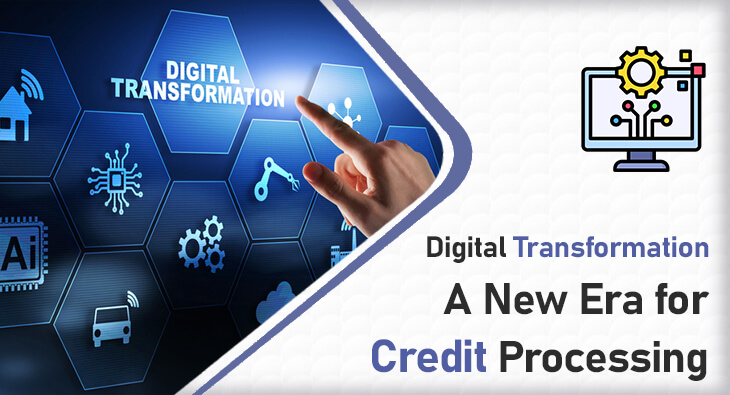Digital Transformation: A New Era for Credit Processing
The world of credit processing is undergoing a major shift as the era of digital transformation takes over. With the rapid advancement of technology, traditional methods of handling credit applications and processing are becoming outdated and inefficient. The rise of digital transformation has opened up a new realm of possibilities for streamlining and modernizing the credit process.
From online applications to automated decision-making, this new era is revolutionizing the way credit processing is handled, benefiting both lenders and borrowers alike. Let’s take a closer look at how digital transformation is transforming credit processing and what it means for the future of lending.
Understanding Digital Transformation in Credit Processing
Digital transformation refers to the integration of digital technology into all aspects of a business, changing how it operates and delivers value to customers. In the context of credit processing, digital transformation involves leveraging technology to streamline and modernize the credit application and processing procedures.
This can include digitizing application forms, utilizing data analytics to assess creditworthiness, and implementing automated decision-making processes. Understanding digital transformation in credit processing is crucial to adapt to the evolving landscape and unlock the numerous benefits it offers, such as improved efficiency, enhanced customer experience, and increased accuracy in credit assessment.
Some Related Blogs
- Importance of Using Merchant Services for Digital Marketing Success
- Merchant Account for Forex Busines | Merchant Stronghold
- Simplifying Cannabis Payment Solutions: Merchant Stronghold
- Echeck Clearance: Understanding the Delay in Process
The Impact of Digital Transformation on the Credit Processing Landscape
Digital transformation has had a profound impact on the credit processing landscape. It has revolutionized the way lenders assess creditworthiness and process applications, making the entire process more efficient and accurate. By leveraging technology, lenders can now analyze vast amounts of data to make informed decisions quickly.
This not only speeds up the credit processing time but also allows for more accurate risk assessments. Additionally, digital transformation has made it easier for borrowers to access credit, with online applications and automated decision-making processes. Overall, digital transformation has transformed the credit processing landscape, benefiting both lenders and borrowers.
The Role of Automation in the Digital Transformation Journey
Automation plays a crucial role in the digital transformation journey of credit processing. By automating various steps in the credit application and processing procedures, lenders can significantly improve efficiency and accuracy. Automated systems can quickly analyze vast amounts of data, allowing for faster decision-making and reducing manual errors.
Additionally, automation eliminates the need for repetitive manual tasks, freeing up time for lenders to focus on more strategic activities. Ultimately, automation streamlines the credit processing journey, enabling lenders to provide a seamless and efficient experience for borrowers.
The Emergence of FinTech and its Influence on Credit Processing
The emergence of FinTech (financial technology) has had a significant influence on credit processing. FinTech companies leverage digital technology to provide innovative financial services, including alternative lending platforms and digital payment systems. These technologies have disrupted traditional credit processing methods, offering borrowers more options and lenders more efficient ways to assess creditworthiness.
![]()
Email us anytime!
Email customer service 24/7
![]()
Call us anytime!
Reach customer care 24/7 at +1 (727) 330-3944
FinTech has also enabled the rise of peer-to-peer lending, where individuals can borrow directly from others without involving traditional financial institutions. This democratization of lending has expanded access to credit for underserved populations and is reshaping the credit processing landscape.
The Importance of Cybersecurity in Digital Transformation
In the era of digital transformation, cybersecurity has become a paramount concern in credit processing. With the increased use of technology and data-driven processes, the risk of cyber threats and data breaches is higher than ever. Ensuring robust cybersecurity measures is crucial to protecting sensitive customer information and maintaining trust in the lending industry.
Implementing strong encryption, multi-factor authentication, and regular security audits are essential steps in safeguarding credit processing systems. By prioritizing cybersecurity, lenders can not only protect their customers but also maintain the integrity of the credit processing landscape in the digital world.
The Future of Credit Processing in a Digital World
As technology continues to advance, the future of credit processing looks promising in the digital world. With the ongoing digital transformation, we can expect even more streamlined and efficient credit application and processing procedures. Automation will play a key role in speeding up decision-making processes and reducing manual errors.
The emergence of FinTech will continue to reshape the credit processing landscape, offering borrowers more options and lenders innovative ways to assess creditworthiness. However, it’s important to prioritize cybersecurity to protect sensitive customer information and maintain trust in the lending industry. Overall, the future of credit processing in a digital world holds exciting possibilities for lenders and borrowers alike.





